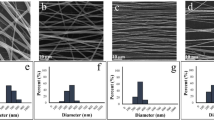Summary
Introduction: Perfluorocarbone liquids (PFCL) enable explantation of intraocular lenses (IOL) dislocated into the vitreous. Because of their relatively high specific weight, the IOL can be floated off the retina and repositioned in the anterior segment. If the IOL surface is affected by contact with PFCL is still unknown. We were interested in the extent of PFCL contact with different IOL materials, having in mind a repositioning of a dislocated IOL into the posterior chamber. We investigated the adherence of PFCL to different IOL surfaces.
Materials and methods: The following IOL materials were tested: Group I: acrylate/methacrylate polymers: (a) PMMA, compression molding; (b) PMMA, compression molding, heparin-surface modified; (c) poly-hydroxyethylmethacrylate (polyHEMA); (d) phenylethylacrylate, phenylethylmethacrylate; (e) methylmethacrylate, HEMA; (f) methylmethacrylate, hydroxyethylmethacrylate, ethylene glycol dimethacrylate; (g) hydroxyhexylmethacrylate, HEMA. Group II: silicone elastomers: (a) polydimethylsiloxane; (b) polydimethyldiphenylsiloxane. A total of 17 types of standard quality IOLs were obtained from several manufacturers. Each IOL was immersed in PFCL for 3 h. Then each IOL was rinsed with 2 ml balanced salt solution (BSS) and investigated by light microscopy with regard to the extent of PFCL adhesion.
Results: After rinsing with BSS, no PFCL was detectable on any IOL surface. Possible PFCL invasion into an open optic-haptic junction in three-piece IOLs could not be excluded using this method. All IOLs demonstrated optic and haptic surfaces without alterations. The IOL surfaces were comparable to those of new IOLs.
Conclusions: With respect to PFCL-IOL interaction, all IOLs seem to be inert. After luxation of the IOL into the vitreous and IOL elevation by using PFCL, repositioning of the dislocated IOL seems to be possible under special conditions (adequate total diameter, IOL without damage, no open haptic junction in the optic). After rinsing the explanted IOL with BSS prior to reimplantation, the risk of damaging the eye by PFCL remnants on the IOL appears neglibile.
Zusammenfassung
Hintergrund: Flüssiges Perfluorkarbon (PFCL) hat sich unter anderem auch zur Elevation und anschließenden Entfernung einer in den Glaskörper dislozierten Intraokularlinse (IOL) bewährt. Aufgrund des hohen spezifischen Gewichtes von PFCL wird die IOL aufgeschwemmt und kann in den vorderen Augenabschnitt reponiert werden, wo sie z. B. im Sulcus ciliaris refixiert werden kann. Welche Art von Kontakt PFCL mit der IOL eingeht, ist ungeklärt. Da eine Biotoxizität des PFCL bei längerem intraokularem Verbleib wahrscheinlich ist, wird es am OP-Ende möglichst vollständig entfernt. Uns interessierte im Hinblick auf eine Repositionierung der dislozierten IOL in die Hinterkammer die Frage, wie ausgeprägt der Kontakt von PFCL mit den unterschiedlichen IOL-Materialien ist, und ob eine Spülung mit Flüssigkeit eine vollständige Befreiung der IOL von PFCL bewirken kann.
Material und Methode: Folgende IOL-Materialien wurden untersucht: I. Acryl-/Methacrylpolymere: a) Polymethylmethacrylat (PMMA), compression molding, b) PMMA, compression molding, heparinbeschichtet, c) Polyhydroxyethylmethacrylat (Poly-HEMA), d) Phenylethylacryl/Phenylethylmethacryl-Mischung, e) Methylmethacryl/HEMA-Mischung, f) Methylmethacryl/Hydroxyethylmethacryl/Ethylenglykoldimethacryl-Mischung, g) Hydroxyhexylmethacryl/HEMA-Mischung; II. Silikonelastomere: a) Polydimethylsiloxan, b) Polydimethyldiphenylsiloxan. Insgesamt 17 gängige IOL-Typen von verschiedenen Herstellern wurden untersucht. Die IOL wurden für drei Stunden in Perfluordecalin eingetaucht. Anschließend wurden die IOL-Optik und -Haptik mittels 2 ml BSS sorgfältig abgespült und luftgetrocknet. Nach der Spülung wurde jede IOL mittels Lichtmikroskopie auf das Ausmaß der oberflächlichen Anheftung von PFCL-Resten hin untersucht.
Ergebnisse: Auf keinem IOL-Material waren nach der Spülung PFCL-Reste erkennbar. Ein Eindringen und Verbleiben von PFCL in Haptik-Verankerungsräumen im Optikkörper bei dreistückigen IOL nach der Spülung konnte nicht ausgeschlossen werden. Alle IOL wiesen eine unveränderte Oberfläche auf, die der einer fabrikneuen, nicht mit PFCL in Kontakt gebrachten Oberfläche vergleichbar war.
Schlußfolgerung: Alle untersuchten IOL-Materialoberflächen scheinen nach dreistündiger Exposition gegenüber PFCL inert zu sein. Nach Explantation der luxierten IOL unter Zuhilfenahme von PFCL ist eine anschließende Abspülung der explantierten bzw. reponierten IOL mit BSS erforderlich. Unter bestimmten Voraussetzungen (u. a. größerer IOL-Gesamtdurchmesser, schadensfreie IOL, keine Haptikeinlassung im Optikkörper) scheint ein Belassen derselben IOL möglich zu sein, ohne eine Schädigung des Auges durch PFCL-Rückstände auf der IOL befürchten zu müssen.
Similar content being viewed by others
Author information
Authors and Affiliations
Rights and permissions
About this article
Cite this article
Dick, B., Schwenn, O., Stoffelns, B. et al. Adhesion of liquid perfluorocarbone to different IOL materials. A light microscopic investigation. Ophthalmologe 95, 301–306 (1998). https://doi.org/10.1007/s003470050277
Published:
Issue Date:
DOI: https://doi.org/10.1007/s003470050277




